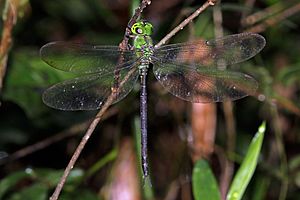Gynacantha facts for kids
Quick facts for kids Gynacantha |
|
|---|---|
 |
|
| Black-kneed duskhawker Gynacantha bullata female, Aburi Botanical Gardens, Ghana |
|
| Scientific classification |
|
| Kingdom: | Animalia |
| Phylum: | Arthropoda |
| Class: | Insecta |
| Order: | Odonata |
| Infraorder: | Anisoptera |
| Family: | Aeshnidae |
| Genus: | Gynacantha Rambur, 1842 |
Gynacantha is a special group, or genus, of dragonflies. These amazing insects belong to the family called Aeshnidae. You might know them as two-spined darners or duskhawkers. They get the name "two-spined" because the female dragonflies have two clear spines under the last part of their body. The name Gynacantha itself comes from Greek words meaning "female" and "thorn," which perfectly describes this unique feature!
Contents
What are Dragonflies?
Dragonflies are fascinating insects with long bodies and two pairs of strong, clear wings. They are known for being excellent flyers. You can often spot them zipping around ponds, lakes, and rivers. They are part of a larger group of insects called Odonata, which also includes damselflies.
The Gynacantha Difference
Gynacantha dragonflies are unique in a few ways. Besides the special spines on the females, they are often called "duskhawkers." This name tells us something important about them. Unlike many other dragonflies that fly during the day, Gynacantha species are most active at dusk and dawn. This means they prefer to hunt and fly when the sun is setting or rising.
Where Do They Live?
Gynacantha dragonflies are found in many parts of the world. They live in warm, tropical, and subtropical areas. You can find them in Africa, Asia, Australia, and parts of the Americas. They usually live near water sources like ponds, slow-moving streams, or even swamps. These places provide the perfect environment for them to hunt and for their young to grow.
Their Habitat
These dragonflies love places with lots of plants and trees. The vegetation gives them places to rest and hide. It also provides shelter for the smaller insects they like to eat. Because they are active at dusk, they often fly in open areas near forests or dense bushes.
What Do They Eat?
Like all dragonflies, Gynacantha species are predators. This means they hunt and eat other insects. They are very skilled hunters in the air.
Hunting Habits
Their diet mainly consists of smaller flying insects. They catch their prey right out of the air using their strong legs. Common meals for them include mosquitoes, flies, and moths. Their excellent eyesight helps them spot tiny insects even in low light conditions.
Life Cycle of a Dragonfly
Dragonflies, including Gynacantha, go through an interesting life cycle called incomplete metamorphosis. This means they don't have a pupa stage like butterflies.
From Egg to Nymph
The life cycle begins when a female dragonfly lays her eggs. She usually lays them in or near water, often on aquatic plants. Once the eggs hatch, tiny creatures called nymphs emerge. These nymphs live underwater.
Underwater Life
Dragonfly nymphs are also predators. They have special mouthparts that shoot out to catch small aquatic creatures. They eat things like tadpoles and other insect larvae. Nymphs can live underwater for months or even years, depending on the species and conditions. As they grow, they shed their skin multiple times in a process called molting.
Emergence and Adult Life
When a nymph is ready to become an adult dragonfly, it crawls out of the water. It usually climbs onto a plant stem or a rock. Then, its skin splits open, and the adult dragonfly emerges. This is a truly amazing sight! The new adult dragonfly will then fly away to hunt, mate, and start the cycle all over again. Adult dragonflies live for only a few weeks or months.
Species of Gynacantha
The Gynacantha genus includes many different species of dragonflies. Each species has its own unique features, but they all share the general characteristics of the genus. Some species are quite common, while others are rare. Scientists continue to study these fascinating insects to learn more about them.

